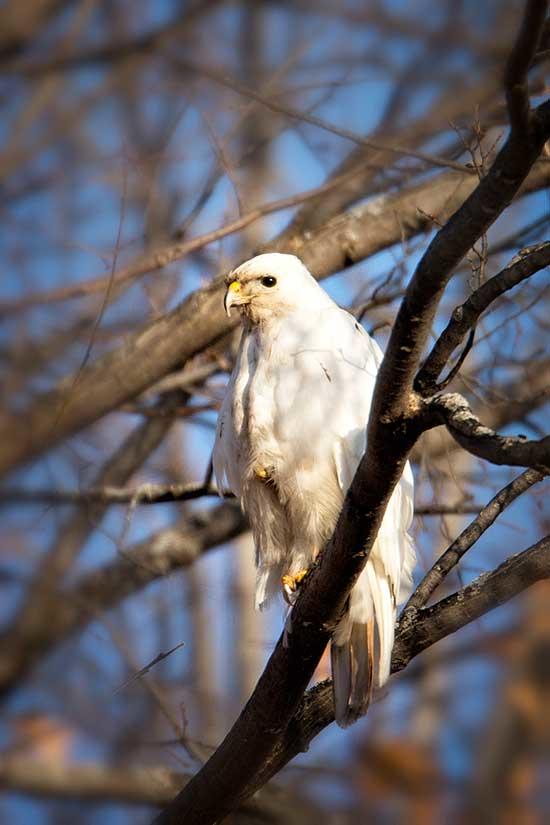Abnormal Colors
 Many years ago, I saw what looked like a completely white red-tailed hawk in the area around the nature center where I have worked for the past 30 years. Occasionally, I would get a call from someone who thought they saw a white gyrfalcon, which would be a good guess, but gyrfalcons are extremely uncommon in our area. With each report, I would go out to investigate, and would find this nearly pure-white red-tailed hawk. Then, for several years, there were no reports of our white friend, and I assumed the white hawk was gone.
Many years ago, I saw what looked like a completely white red-tailed hawk in the area around the nature center where I have worked for the past 30 years. Occasionally, I would get a call from someone who thought they saw a white gyrfalcon, which would be a good guess, but gyrfalcons are extremely uncommon in our area. With each report, I would go out to investigate, and would find this nearly pure-white red-tailed hawk. Then, for several years, there were no reports of our white friend, and I assumed the white hawk was gone.
Then, out of the blue, I got a call reporting a large, white bird in a tree. Of course, I raced over to investigate. What I found was a nearly all-white hawk perched in a tree, fluffed up and braced against the extreme winter cold. Only one problem, it wasn’t the white hawk I had been seeing all these years. Sure, this one was white, but it also had a red tail. The hawk in the past didn’t have a red tail. This leads me to speculate that this bird might be the offspring of the original white hawk.
Abnormalities in bird pigment are actually fairly common. It might not be as extreme as the white red-tailed, but it’s around if you stop and look for it. For example, if you look at the house finches that visit your feeders, you will notice that some are more brightly colored than others. This shows the difference in the amount of melanin, which is the pigment that gives the birds their color. These kinds of variations are normal.
What isn’t normal is a complete lack of color. When a bird completely lacks melanin, it is termed to be albino. It is a result of a genetic mutation that interferes with the production of the enzyme, tyrosinase, which helps to produce melanin. When this happens, they don’t have any color in their feathers, eyes, or any exposed skin. These are complete albinos, and have pink eyes. This can happen in all birds and mammals.
Sometimes, a small amount of melanin is produced, and you get birds like the one I photographed. While most of the body is white the tail remains red. The eyes are dark, and the exposed skin near the bill is yellow. This is called incomplete albinism or leucism. The main difference is that leucism may only affect the bird’s feathers, and does not affect the skin or eyes. Albinism causes a lot of trouble with eyesight but leucism doesn’t.
Plumage color may also be altered by all sorts of environmental factors. Exposure to sunlight can bleach out feathers, making dark feathers lighter. Wear and tear can also change the color of feathers. Some species such as the northern cardinal in winter will have distinct gray edge to each of their bright red feathers. The gray edges slowly wear off during normal activities, and by springtime, when the bird is ready to breed, the birds look bright red. Air pollution can affect feather colors, and soot and dirt can also change the color of feathers.
Diet also plays a role in the color of a bird’s feathers. For example, birds such as wild flamingos, and roseate spoonbills, which are pink in color, will loose their pink color when held in captivity. All of this happens because they are not eating the carotenoid rich food they get in the wild. Without supplemental foods, the birds won’t be pink in captivity.
So, it looks like this genetic abnormality has been passed down in my local red-tailed hawk population. This is just one more reason I enjoy the diversity of what Mother Nature has to offer. Until next time…
Stan Tekiela is an author / naturalist and wildlife photographer who travels the U. S. to study and capture images of wildlife. He can be followed on www.face book.com and twitter. com. He can be contacted via his web page at www.naturesmart.com
